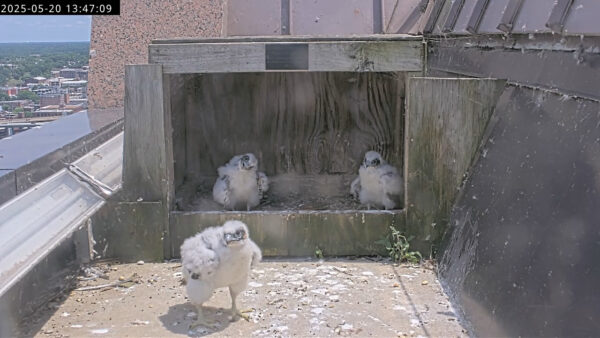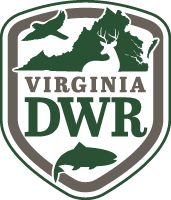Growing up Fast!

One of the falcon chicks ventures outside of the nest box.
It may be hard to believe but the trio of falcon chicks downtown are almost four weeks old! Primary feathers can now be easily detected on the chicks as they develop along the chick’s wings and will soon be followed by the emergence of body feathers which will give the chicks a more mottled-looking appearance. In addition to feather development, the chicks have begun exploring their surroundings outside of the nest box. As the trio of birds become increasingly mobile and better able to walk around, they may wander off camera for several hours at a time, or even spend the night off camera. This is a normal part of peregrine falcon chick development and has taken place in past years with other broods. There are several other sheltering opportunities along the ledge, and viewers should not become overly concerned if they are not able to detect the chicks on camera as reliably as they used to. Further, the parents will continue to watch over the chicks and provide them with prey items.
Considering their age, it also means banding is just around the corner. Pending no inclement weather, Virginia Department of Wildlife Resources biologists plan on visiting the Riverfront Plaza building on Tuesday, May 27th to band the falcon chicks. This will be an incredibly exciting year for us, as we will be accompanied by the winners from our first ever Falcon Banding Day Raffle. We want to extend our thanks to everyone who supported our wildlife conservation work by purchasing a ticket and our congratulations to the winners who have already been notified by DWR staff.
On the day of banding, three of the chicks will be between 33 and 31 days old. In addition to receiving their life-long leg bands, each chick will be weighed and measured and we will determine its sex. Banding is an incredibly important tool used to facilitate the identification of individuals throughout the remainder of their lives. This can yield information on where these young birds travel in the quest to establish their own individual breeding territories, as well as on their lifespan, productivity (number of eggs laid and chicks hatched) and relationship to other banded falcons with which they may interact. As a whole, banding allows biologists to better track the Virginia falcon population as it continues on its path to recovery.
On banding day, DWR biologists will also deploy the pen that has been used in previous years to prevent early fledge events. The camera will be turned off for up to a few hours while staff are banding the chicks and installing the pen. After this work has been completed, the chicks will be returned to the nest box and the camera will be turned back on. Be on the lookout for a follow-up post which will contain updates from banding day!

